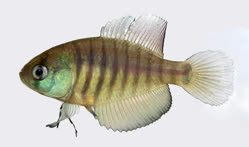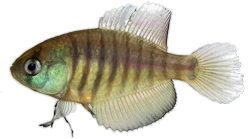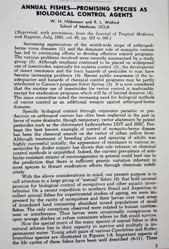|
|
In 1972, AKA members Dr. Dave Schleser and Charlie Harrison managed to import live specimens of Garcialebias adloffi and Cynopoecilius melanotaenia. Both species had been in the post WWII hobby briefly thanks to an early 1960's scientific importation where they were used as an experiment in mosquito control in California rice fields. AKA'er Dr. Dick Haas was part of this fascinating but failed experiment. Melanotaenia had also made it to Europe shortly before this US importation. Both species soon disappeared so by the late 60's neither was being kept.
Schleser and Harrison reached out to Viggio Schultz in Sao Paolo, Brazil to arrange their shipment, which was also to include Megolebias wolterstorffi. Wolterstorffi had been part of the earlier scientific importation to California and survived for awhile in the 1960's killie hobby but by 1972 it was gone. Schultz had collected the fish for the earlier California importation and he agreed to help Dave and Charlie. (Schultz had published an account of this earlier collection in the Aquarium Journal and Tropical Fish Hobbyist and as pictured below JAKA published an account by the scientist involved.) Dave's and Charlie's first attempt at an importation failed as the fish arrived dead but a second attempt produced live adloffi and melanotaenia. The wolterstoffi either couldn't be found by Schultz or arrived dead. My memory is unclear on that point. The offspring of both species were distributed in the AKA. Melanotaenia turned out to be the easier of the two to breed. Adloffi was odd. Eggs seemed to disappear in storage. From some unknown inspiration, Dave decided to try storing adloffi eggs in especially moist peat moss formed into a tightly shaped golfball. That did the trick! Incubation worked and after 3 months fry. I found this odd requirement for successful storage fascinating. I wanted to see for myself. When visiting Detroit AKA'ers in 1974, the great breeder Earl Lanstra gave me a young pair of adloffi. I followed the golfball method for storing their peat as well as normal loose peat storage. Sure enough, the golfball peats hatched fry and normally stored peat hatched zero fry. My first 8 fry had me so excited that I decided to try a new method of raising fry to insure pairs. A Russian killie breeder had found that when 2 fry were raised alone, one almost always obtained a pair. Well, it worked. I had 4 pair! I was pleased to give Dr. Glen Collier a pair during a visit by Glen as years before, when Glen was a student at Texas A&M he had invited me to be part of the first Houston killifish club that he was creating. I only kept adloffi for a few generations as they were never prolific. I especially loved the two little black dots on the female's caudal peduncle. A lovely and peaceful species. Robert Ellerman, 2025
|



